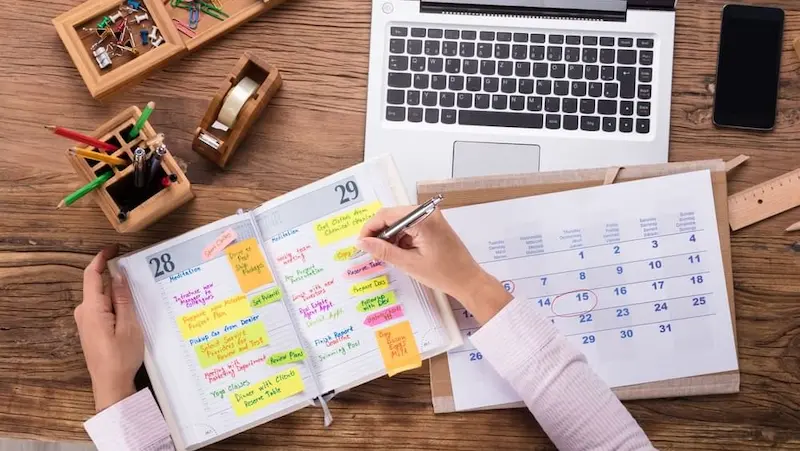In the journey of education, few things hold as much significance as effective exam preparation. It’s the bridge between the knowledge we’ve acquired and the results we hope to achieve. Whether it’s a crucial test in school, a career planning defining certification, or any other assessment, the way we prepare can make all the difference. It’s the compass that guides us through the maze of information, ensuring we’re not just armed with facts but also the confidence to excel. So, let’s embark on a brief exploration of the pivotal role that effective exam preparation plays in our educational pursuits and beyond.
Table of contents
Tip 1. Understand the Exam
Exams are the dreaded word that can send shivers down our spines. They often come with a mix of anxiety and anticipation. But what if I told you that there’s a way to make exams seem less intimidating? The first step is simple: Understand the Exam.

Let’s break this down into two crucial aspects:
1. Types of exams and their formats
Exams come in all shapes and sizes. There are multiple-choice tests, essay exams, practical assessments, and everything in between. Each type of exam has its own unique format and requirements. Understanding the format will help you tailor your study approach.
For instance, multiple-choice tests demand a good grasp of facts and concepts, while essay exams require you to synthesize effective communication tips for your knowledge effectively. Knowing the format will guide your preparation.
2. Reviewing the syllabus and exam guidelines
It’s surprising how many student life hacks skip this step, but it’s a game-changer. Your syllabus is like a treasure map; it shows you what topics will be covered in the exam. Review it carefully and cross-reference it with your class notes and textbooks.
Equally important are the exam guidelines provided by your instructor or institution. These guidelines may include information about the exam duration, the number of questions, and any specific instructions to follow during the exam. Ignoring these guidelines can lead to costly mistakes.
Tip2. Create a Study Schedule

The Benefits of a Structured Study Plan
1. Time Management: One of the most significant advantages of a study schedule is improved time management. It helps you allocate dedicated time for each subject or task, ensuring you make the most of your available hours.
2. Consistency: Consistency is key when it comes to learning. A study schedule establishes a routine, making it easier to stay on track and build a habit of studying regularly.
3. Reduced Stress: Knowing what you need to study and when can significantly reduce stress. You won’t have to scramble at the last minute, trying to cram everything in before exams or deadlines.
4. Goal Achievement: With a well-structured study abroad plan, you can set clear goals and milestones for yourself. This sense of purpose can boost your motivation and keep you focused on your objectives.
Tips for Creating a Realistic Schedule
1. Assess Your Priorities: Start by evaluating your current commitments, including classes, work, and personal development activities. Understand how much time you realistically have available for studying.
2. Break It Down: Divide your study material into manageable chunks. Trying to study everything at once can be overwhelming. Break it down into smaller, more digestible pieces.
3. Set Specific Goals: Define what you want to accomplish during each study session. Having clear objectives can make your study time more productive.
4. Be Realistic: Don’t overcommit. Be honest with yourself about how much you can accomplish in a day. It’s better to allocate a realistic amount of time to each task than to set yourself up for failure.
5. Include Breaks: Schedule short breaks between study sessions. Taking breaks can help you recharge and maintain your focus.
Tip3. Organize Your Study Space

Creating a Conducive Study Environment
Imagine trying to concentrate on your textbooks while sitting in a cluttered, noisy room with distractions all around. It’s not an ideal scenario, right? That’s why it’s essential to set up a study space that encourages learning.
Here are some tips for creating a conducive study environment:
1. Choose the Right Location: Select a quiet and comfortable place where you can study without interruptions. This could be a corner of your room, a library, or a coffee shop with the right ambiance.
2. Minimize Distractions: Keep your study space free from distractions like your smartphone, TV, or noisy roommates. Consider using noise-canceling headphones if you need to block out external sounds.
3. Good Lighting: Ensure that your study area is well-lit. Natural light is the best, but if that’s not possible, invest in a good desk lamp.
4. Comfortable Seating: A comfortable chair and desk or table at the right height can make a significant difference in your study comfort.
Tools and Supplies for Efficient Studying
Once you’ve set up a suitable study environment, it’s time to equip yourself with the right tools and supplies to enhance your learning experience.
Here’s a checklist of essentials:
1. Notebooks and Pens: Organize your notes effectively by keeping notebooks for each subject or topic. Use different colored pens for highlighting and making your notes visually appealing.
2. Laptop or Computer: A reliable computer or laptop is essential for research, typing assignments, and accessing online resources.
3. Internet Connection: Make sure you have a stable internet connection for online research and accessing study materials.
4. Study Materials: Gather all your textbooks, class notes, and study guides in one place, so you can easily access them when needed.
Tip 4. Gather Study Materials

Textbooks, Notes, and Online Resources:
1. Textbooks are like the backbone of your study materials. They provide you with structured content that’s essential for understanding your subject matter.
2. Notes are your personalized insights and summaries. They help you remember key points and make complex topics more accessible.
3. Online resources are a treasure trove of knowledge. Websites, articles, and videos can offer fresh perspectives and supplementary information.
Pro tip: Organize your textbooks and notes neatly. Use color-coding or digital note-taking apps to make them even more accessible.
Using Digital Tools for Research:
1. The digital age has given us access to a vast world of information. Make the most of it! Use search engines, academic skillls databases, and digital libraries to find relevant research materials.
2. Consider using reference management tools like Zotero or Mendeley to keep your research organized and easily cite your sources.
Pro tip: When researching online, be sure to evaluate the credibility of the sources you find. Not everything on the internet is accurate or reliable.
Tip5. Practice with Past Papers

The Value of Solving Previous Exam Papers
1. Get Inside the Examiner’s Mind: Past papers are like a sneak peek into the mind of the examiner. By working through them, you’ll get a sense of the types of questions they like to ask and the format they prefer. This insight is pure gold when it comes to preparation.
2. Time Management: AP exams are often a race against the clock. Solving past papers helps you understand how to manage your time effectively during the actual exam. You’ll learn when to move on from a tricky question and when to linger a bit longer.
3. Content Familiarity: When you solve past papers, you’ll encounter questions on various topics. This not only tests your knowledge but also helps you identify weak spots in your understanding. It’s a fantastic way to focus your revision.
Strategies for Reviewing and Analyzing Solutions
Now that you know why solving past papers is essential, here are some strategies to make the most of this practice:
1. Simulate Exam Conditions: Treat past papers like the real deal. Find a quiet space, set a timer, and attempt the paper just as you would during the exam. This will help you get used to the pressure and time constraints.
2. Analyze Your Mistakes: After completing a paper, don’t just move on. Go through your answers and see where you went wrong. Did you misinterpret a question? Did you make a calculation error? Learning from your mistakes is one of the most effective ways to self-improvement.
3. Seek Guidance: If you’re stuck on a question, don’t hesitate to seek help from a teacher, tutor, or classmate. Understanding the solutions is as crucial as attempting the questions.
Tip6. Stay Healthy

The Connection Between Physical and Mental Well-being
Imagine your body and mind as two sides of the same coin. When one side is tarnished, the other side is affected too. Research has consistently shown that maintaining good physical health has a direct and positive impact on your mental health. Regular exercise, a balanced diet, and adequate sleep are not just good for your body; they’re essential for your mind.
Exercise, for instance, triggers the release of endorphins, those wonderful feel-good chemicals that can help alleviate stress, anxiety, and depression. A balanced diet provides your brain with the nutrients it needs to function optimally. And quality sleep is like a reset button for your mind, ensuring you wake up refreshed and ready to face the day’s challenges.
Tips for Maintaining a Balanced Lifestyle
Now that we understand the intimate connection between our physical and mental well-being, let’s explore some practical tips for maintaining a balanced lifestyle:
1. Stay Active: Incorporate regular physical activity into your routine. It doesn’t have to be strenuous; even a daily walk can work wonders for your mood.
2. Eat Mindfully: Pay attention to what you put on your plate. Opt for a variety of nutritious foods that nourish both your body and mind.
3. Prioritize Sleep: Establish a consistent sleep schedule and create a calming bedtime routine. Aim for 7-9 hours of quality sleep each night.
4. Manage Stress: Practice stress-reduction techniques like meditation, deep breathing, or yoga to keep stress levels in check.
5. Stay Hydrated: Water is vital for overall health, including brain function. Make sure you’re drinking enough throughout the day.
Tip7. Time Management

Strategies for Efficient Time Management
1. Prioritize Your Tasks: Start your day by identifying your most important tasks. The Eisenhower Matrix is a handy tool that categorizes tasks into four quadrants: urgent and important, important but not urgent, urgent but not important, and neither urgent nor important. Focus your energy on the important and urgent tasks to maximize productivity.
2. Set SMART Goals: Specific, Measurable, Achievable, Relevant, and Time-bound (SMART) goal setting provides clarity and direction. Break larger goals into smaller, manageable tasks to track progress and stay motivated.
3. Create a To-Do List: Write down your tasks for the day, week, or month. This simple act can help you visualize your workload and stay organized.
4. Time Blocking: Allocate specific time blocks for different tasks. This helps you concentrate fully on one task at a time and minimizes distractions.
5. Use Technology Wisely: Utilize productivity tips apps and tools to streamline your work. Calendar apps, task management tools, and project management software can help you stay on top of deadlines.
Dealing with Procrastination
Procrastination is a common hurdle in time management. It’s that nagging urge to put off important tasks in favor of more enjoyable or less demanding activities. Here’s how to tackle it:
1. Understand the “Why”: Reflect on why you’re procrastinating. Is it fear of failure, lack of interest, or feeling overwhelmed? Identifying the root cause is the first step toward overcoming procrastination.
2. Break Tasks into Smaller Steps: Big tasks can be intimidating. Divide them into smaller, more manageable steps. Completing these mini-tasks will build momentum and boost your confidence.
3. Set a Deadline: Create a sense of urgency by setting self-imposed deadlines. Use the Pomodoro Technique, working in short bursts with regular breaks, to maintain focus.
4. Minimize Distractions: Identify your distractions and take steps to minimize them. Turn off social media notifications, clear your workspace, and let others know when you need focused time.
5. Reward Yourself: After completing a task, reward yourself. Whether it’s a small treat, a short break, or a fun activity, positive reinforcement can motivate you to tackle the next task.
Tip8. Mindfulness and Relaxation

Reducing Exam-Related Stress
Let’s face it – stress and exams go hand in hand. The pressure to perform can often feel overwhelming. However, there are several strategies you can employ to keep that stress at bay:
1. Time Management: Plan your study schedule well in advance. Break your study sessions into
manageable chunks with short breaks in between. This prevents last-minute cramming and reduces stress.
2. Healthy Lifestyle: Eating well, staying hydrated, and getting enough sleep are non-negotiables. A well-nourished and rested mind performs better under pressure.
3. Exercise: Physical activity can be a great stress reliever. Take short breaks to stretch or go for a walk to clear your mind.
Incorporating Mindfulness into Your Routine
Mindfulness is the practice of staying present and fully engaging with the moment. It’s a simple yet effective way to calm your mind and reduce stress. Here’s how you can incorporate it into your daily routine:
1. Breathing Exercises: Take a few minutes each day to focus on your breath. Breathe in deeply, hold for a few seconds, and exhale slowly. This simple exercise can help you stay centered and reduce anxiety.
2. Meditation: Try meditation apps or guided meditation sessions to clear your mind and improve concentration.
3. Yoga: Yoga combines physical movement with mindfulness, promoting relaxation and flexibility. Even a short yoga session can do wonders for your stress levels.
4. Mindful Eating: Pay attention to what you eat. Savor each bite, and avoid overindulging in junk food, which can lead to energy crashes and added stress.
Tip9. Final Review and Revision

The Importance of a Comprehensive Revision
Think of revision as the fine-tuning phase of your writing journey. It’s where you take your rough diamond and transform it into a sparkling gem. Here’s why it’s so crucial:
1. Enhancing Clarity: During revision, you can eliminate any confusing or convoluted sentences, ensuring your message comes across crystal clear to your readers.
2. Polishing Style: A thorough revision allows you to refine your writing style, making it more engaging, concise, and impactful.
3. Grammar and Mechanics: Typos and grammatical errors can be distracting. Revision gives you the chance to catch these, ensuring your work appears professional.
4. Coherence and Flow: You can check that your ideas flow seamlessly from one to the next, creating a smooth and logical progression.
5. Strengthening Arguments: If you’ve missed any key points or need to bolster your arguments, revision is the time to do it.
Last-Minute Tips for Success
Now that you understand why revision is vital, here are some last-minute tips to make it as effective as possible:
1. Take a Break: Give yourself some distance from your work before revising. This fresh perspective will help you spot errors more easily.
2. Read Aloud: Reading your work aloud can help you catch awkward phrasing and grammatical errors that you might overlook when reading silently.
3. Seek Feedback: If possible, have someone else read your work and provide feedback. A fresh set of eyes can uncover issues you might have missed.
4. Focus on Specific Elements: Break your revision into manageable chunks. First, check for grammar and punctuation, then move on to clarity and style.
5. Use Tools: Grammar and spell-checking software can be valuable, but don’t rely on them entirely. They can miss context-specific errors.
Conclusion
In the journey of life, embracing a positive mindset is like having a secret weapon for success. It’s the unwavering belief in ourselves, the ability to see opportunities in challenges, and the courage to keep moving forward. When we choose positivity, we create a ripple effect, not only in our own lives but in the lives of those around us.
It’s the fuel that propels us through adversity, the light that guides us through the darkest of times. So, let’s continue to nurture this precious mindset, for it is the cornerstone of our accomplishments and the key to unlocking the doors of our dreams.
To get your hands on more such articles, educational content, and free resources on coding for kids, robotics courses, game development, etc., check out the BrightCHAMPS Blog Page now!
Frequently Asked Questions
A1. To create a study plan that suits you, start by setting clear goals, prioritizing subjects, and allocating dedicated time slots. Regularly assess and adjust your plan as needed to stay on track.
A2. Engage in active learning by summarizing key points, teaching the material to someone else, or solving problems related to the subject. Active participation boosts comprehension and retention.
A3. The choice between digital and handwritten notes depends on your preference. Experiment with both to see which method helps you remember and understand better.
A4. To cope with test anxiety, practice deep breathing, positive self-talk, and visualize success. Arrive early, stay calm, and trust in your preparation. Remember, it’s just one test.
A5. Effective review methods include creating concise study aids like flashcards, summarizing notes, and practicing with past exams or questions. Focus on weak areas and avoid last-minute cramming.


 We are an army of educators and passionate learners from BrightChamps family, committed to providing free learning resources to kids, parents & students.
We are an army of educators and passionate learners from BrightChamps family, committed to providing free learning resources to kids, parents & students.














